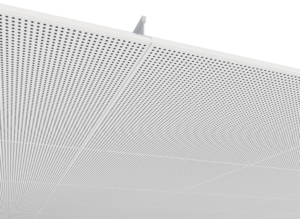Acoustic Ceilings
Objective or room acoustical measures If the neighbour is too loud, the ceilings and party walls between living areas can be acoustically upgraded, and should the sound of traffic on the street be too loud, the window can be closed. But what do you do if the sound source is in the room where you are. This is where room acoustics comes into play. The term noise is simply too general. Within a room it is not just the reduction of the noise level created by the colleagues, making the carefree uproar of children in the kindergarden easier to withstand or to reduce the noise emissions of machines during operation. For some rooms it is necessary to direct the sound to achieve the desired effect.
In auditoria, for example, the primary concern is to provide all of the occupants with sufficient sound energy to ensure that the spoken word can be understood in the furthest away row without any loss in the intelligibility of voices.
Particularly in respect of the architectural trends towards smooth surfaces such as fair-faced concrete, glass and purist furnishing, the requirement for knowledge regarding the necessity of room acoustics is very significant.
- Poor room acoustics can cause a whole range of problems with a diverse range of room usages.
- Sound reflection interference with negative effects on the intelligibility of voices impair the ability to concentrate with verbal presentations.
- Poor provision with primary sound at voice-based events and the loss of comprehension of word and speech leads to agitation and a “background murmur” of those present.
- Superposition of conversations involving several speakers leads to poor room acoustics and to the acoustic quality becoming indistinct, and to an increase in speech volume creating a further worsening of this effect
- No or insufficient consideration of the acoustic quality of the room lead to a higher noise level in enclosed areas and subsequently to
- Increased demands on the cognitive processes
- Simply to less reduction in the noise level, even at extended distances
- Aural (hearing-related or auditory) and extra-auditory (effects of noise on the psyche and organism unrelated to hearing) damage




